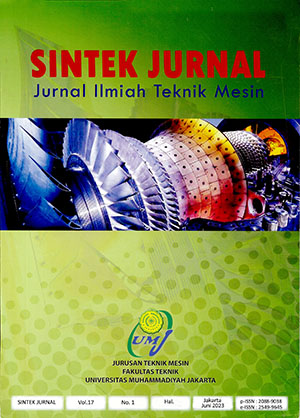Brilliability and fracture strength of float glass under static and dynamic loads due to radiation heat
Main Article Content
Abstract
Article Details
- Articles published in SINTEK JURNAL are licensed under a Creative Commons Attribution-ShareAlike 4.0 International license. You are free to copy, transform, or redistribute articles for any lawful purpose in any medium, provided you give appropriate credit to the original author(s) and SINTEK JURNAL, link to the license, indicate if changes were made, and redistribute any derivative work under the same license.
- Copyright on articles is retained by the respective author(s), without restrictions. A non-exclusive license is granted to SINTEK JURNAL to publish the article and identify itself as its original publisher, along with the commercial right to include the article in a hardcopy issue for sale to libraries and individuals.
- By publishing in SINTEK JURNAL, authors grant any third party the right to use their article to the extent provided by the Creative Commons Attribution-ShareAlike 4.0 International license.
References
Asahimas Flat Glass tbk, “Modified Float Process.” Jakarta Tank Furnace 3, Januari 1983.
R. V. Kumar and J. Buckett, “Float Glass,” Reference. Module in Material Science Materials Engineering, no. February 2015, pp. 1–8, 2017.
G. K. Kumar, S. Saboor, and T. P. A. Babu, “Experimental and Theoretical Studies of Window Glazing Materials of Green Energy Building in Indian Climatic Zones,” Energy Procedia, vol. 109, no. November 2016, pp. 306–313, 2017.
K. Jolley and R. Smith, “Nuclear Instruments and Methods in Physics Research B Iron phosphate glasses : Structure determination and radiation tolerance,” Nucl. Inst. Methods Phys. Res. B, vol. 374, pp. 8–13, 2016.
J. C. Mauro and M. M. Smedskjaer, “Statistical mechanics of glass,” Journal of Non Crystalline Solids, vol. 396–397, pp. 41–53, 2014.
W. J. Weber, “Radiation and Thermal Ageing of Nuclear Waste Glass,” Procedia Materials Science, vol. 7, pp. 237–246, 2014.
B. W. Stuart, M. Gimeno-fabra, J. Segal, I. Ahmed, and D. M. Grant, “Applied Surface Science Mechanical , structural and dissolution properties of heat treated thin-film phosphate based glasses,” Applied Surface Science, vol. 416, pp. 605–617, 2017.
G. Tunjai, A. Chotipong, and C. Sutthirat, “The Leachate of Lead from the Crucibles Undergone Ruby Heat Treatment with Lead Glass Additive,” APCBEE Procedia, vol. 10, pp. 91–95, 2014.
Q. S. Wang, Y. Zhang, J. H. Sun, J. Wen, and S. Dembele, “Temperature and thermal stress simulation of window glass exposed to fire,” Procedia Engineering., vol. 11, pp. 452–460, 2011.
Q. Wang, H. Chen, Y. Wang, and J. Sun, “Thermal shock effect on the glass thermal stress response and crack propagation,” Procedia Engineering., vol. 62, pp. 717–724, 2013.
Y. Zhang, Q. S. Wang, X. Bin Zhu, X. J. Huang, and J. H. Sun, “Experimental study on crack of float glass with different thicknesses exposed to radiant heating,” Procedia Engineering., vol. 11, pp. 710–718, 2011.


